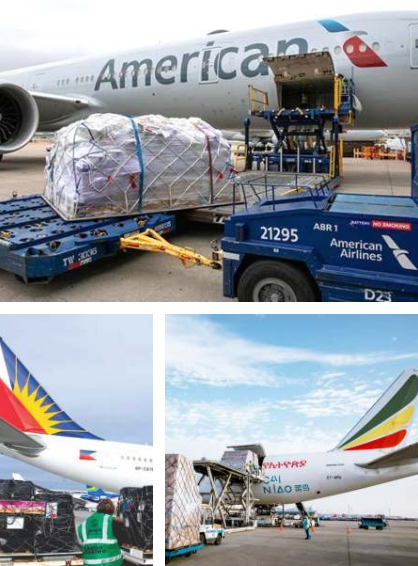Global air cargo industry posts stellar performance in 2021
Demand up by nearly 19% but supply chain challenges remain
GENEVA, Switzerland—The global air cargo demand went up by 18.7 percent in 2021 compared to 2020, year-on-year, making it the industry’s second best performance (behind 2010’s 20.6% gain) since the International Air Transport Association began monitoring cargo output in 1990.
IATA said the growth outpaced the 9.8% rise in global goods trade by 8.9 percentage points. Economic conditions continue to support air cargo growth noting that the recent surge in COVID-19 cases in many advanced economies has created strong demand for PPE shipments, which are usually carried by air, it added.
 Challenges, however, still confront the industry, particularly in the supply chain, due to labor shortages, partly due to employees being in quarantine, insufficient storage space at some airports and processing backlogs continue to put pressure on supply chains.
Challenges, however, still confront the industry, particularly in the supply chain, due to labor shortages, partly due to employees being in quarantine, insufficient storage space at some airports and processing backlogs continue to put pressure on supply chains.
“Air cargo had a stellar year in 2021. For many airlines, it provided a vital source of revenue as passenger demand remained in the doldrums due to COVID-19 travel restrictions. Growth opportunities however were lost due to the pressures of labor shortages and constraints across the logistics system. Overall, economic conditions do point towards a strong 2022,” said Willie Walsh, IATA’s Director General.
“December saw a relief in supply chain issues that enabled an acceleration of cargo growth. “Some relief on supply chain constraints occurred naturally in December as volumes decreased after peak shipping activity ended in advance of the Christmas holiday. This freed capacity to accommodate front-loading of some Lunar New Year shipments to avoid potential disruptions to flight schedules during the Winter Olympic games.
“And overall December cargo performance was assisted by additional belly-hold capacity as airlines accommodated an expected year-end boost to travel. As shortages of labor and storage capacity remain, governments must keep a sharp focus on supply chain constraints to protect the economic recovery,” Walsh noted.
2021 Regional Performance
Strong variations were evident in the regional performance of air cargo in 2021 compared to 2019. North American carriers were the strongest performers, reporting an annual increase in international demand of 20.2%. Middle East and African carriers also reported double digit growth in international demand in 2021 (10.6% and 11.3%, respectively) compared to 2019. Asia-Pacific and European carriers saw international demand rise 3.6% in 2021 compared to 2019. And Latin American carriers were the only ones to record a contraction in international demand of 15.2% compared to 2019.
 Asia-Pacific airlines reported a rise in international demand of 3.6% in 2021 compared to 2019 and a fall in international capacity of 17.1%. In December airlines in the region posted an 8.8% increase in international demand compared to 2019. Demand for goods manufactured in the region remains strong, including PPE. International capacity remained constrained in December down 10% compared to the same month in 2019.
Asia-Pacific airlines reported a rise in international demand of 3.6% in 2021 compared to 2019 and a fall in international capacity of 17.1%. In December airlines in the region posted an 8.8% increase in international demand compared to 2019. Demand for goods manufactured in the region remains strong, including PPE. International capacity remained constrained in December down 10% compared to the same month in 2019.
 North American carriers posted a 20.2% increase in international demand in 2021 compared to 2019 and a growth in international capacity of 0.2%. The region was the only one to record a growth in capacity in 2021 compared to 2019. In December carriers in the region posted an increase of 20.5% in international demand. The region’s carriers continue to benefit from strong consumer demand for goods. International capacity grew 6.2% compared to December 2019.
North American carriers posted a 20.2% increase in international demand in 2021 compared to 2019 and a growth in international capacity of 0.2%. The region was the only one to record a growth in capacity in 2021 compared to 2019. In December carriers in the region posted an increase of 20.5% in international demand. The region’s carriers continue to benefit from strong consumer demand for goods. International capacity grew 6.2% compared to December 2019.
European carriers reported a 3.6% increase in international demand in 2021 compared to 2019 and a fall in capacity of 17.4%. In December airlines posted an increase in international demand of 6% compared to 2019. International capacity was down 5.9% in December 2021 compared to pre-crisis. European carriers have been significantly affected by supply chain and airport congestion and localized capacity constraints.
Middle Eastern carriers reported an increase in international demand of 10.6% in 2021 compared to 2019 and a fall in international capacity of 10.1%. Growth decelerated towards the year-end, partly driven by a downward trend in volumes on the large Middle East-Asia route. In December airlines in the region recorded a 5.7% increase in international demand compared to December 2019. International capacity decreased by 9.2% in December compared to the same month in 2019.
Latin American carriers reported a decline in international demand of 15.2% in 2021 compared to 2019 and a fall in capacity of 30.2%. Airlines registered in Latin America had a challenging year, as several were engaged in lengthy restructuring processes. That said, the restructuring processes are coming to an end, and December’s performance was the best of the year, with carriers in the region reporting a 2.9% decline in international demand compared to December 2019. This was a significant improvement on the 13.4% decline the previous month. Capacity remained heavily constrained in December, down 26.1% on pre-crisis levels.
African airlines saw international demand grow 11.3% in 2021 compared to 2019 and a fall in international capacity of 14.6%. Growth in the region has been dynamic for most of the year, driven by the strength of the Africa-Asia route. In December, international demand grew by 7.6% with international capacity falling 19.4% as compared to the same month in 2019.










